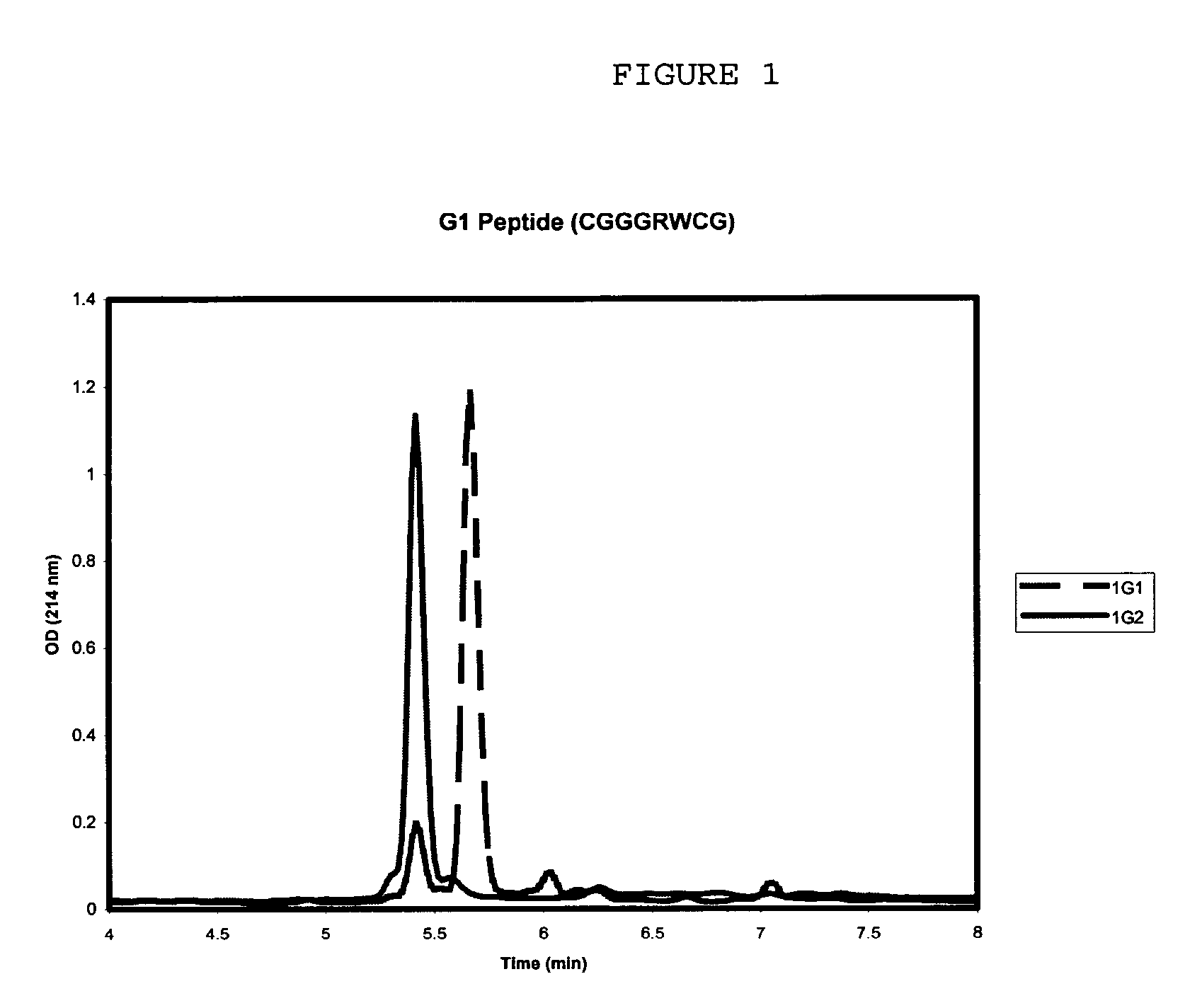Peptide with osteogenic activity
a peptide and osteogenic technology, applied in the direction of peptide/protein ingredients, peptide sources, prostheses, etc., can solve the problems of inability to heal fractures, inadequate bone growth, undesirable cosmetic and/or mechanical effects,
- Summary
- Abstract
- Description
- Claims
- Application Information
AI Technical Summary
Problems solved by technology
Method used
Image
Examples
example 1
Proliferative Response of Human Osteoblasts
[0137]The effect of the peptide (CGGGRWCG, Cys-Gly-Gly-Gly-Arg-Trp-Cys-Gly (SEQ. ID NO: 1)) on the stimulation of osteoblast proliferation was assessed in a short-term assay via measurement of the amount of the nucleotide thymidine that was incorporated into newly synthesized DNA.
[0138]Cys-Gly-Gly-Gly-Arg-Trp-Cys-Gly (SEQ. ID NO: 1) peptides were synthesized by Invitrogen Corporation (Carlsbad, Calif.).
[0139]Primary human osteoblasts were trypsinized and cell counts determined. Cells were resuspended at a concentration of 0.5×105 cells / ml in growth medium [Dulbeccos Modified Eagles Medium (DMEM) 10% Fetal Bovine Serum (FBS), 100 units Penicillin and 50 μg / ml Streptomycin]. A 100 μl aliquot of cells was added to each well in a 96 well dish. Cells were allowed to adhere for 24 hours and then refed with DMEM containing 0.5% FBS for 24 hours. Thereafter, several concentrations (10, 100, 500 μg / ml final concentration) of peptide in DMEM containi...
example 2
Proliferative Response of Human Osteoblasts Treated with Peptide (SEQ. ID NO: 1) versus BMP-2
[0145]Experiments were performed comparing the stimulatory effect of the CGGGRWCG peptide (SEQ. ID NO: 1) to BMP-2. The experiments were set up as described for Example 1, with proliferation assessed by measurement of thymidine incorporation into newly synthesized DNA. Following serum starvation, cells were treated with either the peptide or BMP-2 in DMEM containing 0.5% FBS. These plates were incubated at 37° C. in 5% CO2 for 48 hours and processed for analysis as mentioned in Example 1. The results are shown in Table 2.
[0146]
TABLE 23H-Thymidine Incorporation Into OsteoblastsTreatmentCPM0.1% BSA1548 + / − 198CGGGRWCG (SEQ. ID NO: 1; 200 ug / ml)3446 + / − 333BMP-2, 10 ng / ml4232 + / − 155 10% FBS6640 + / − 223
[0147]Table 2 shows that osteoblast proliferation was stimulated two fold and was similar to that observed with BMP-2.
example 3
Proliferative Response of Human Chondrocytes Treated with Peptide
[0148]The effect of the peptide CGGGRWCG (SEQ. ID NO: 1) on stimulation of human chondrocyte proliferation was assessed by thymidine incorporation as described above. The experiments were set up as detailed in Example 1. Following serum starvation, cells were treated with the peptide at concentration of 10, 100, and 500 μg / ml of peptide in DMEM containing 0.5% FBS. These plates were incubated at 37° C. in 5% CO2 for 48 hours and processed for analysis as described in Example 1. The results are shown in Table 3.
[0149]
TABLE 33H-Thymidine Incorporation Into ChondrocytesTreatmentCPM0.1% BSA632 + / − 61CGGGRWCG (SEQ. ID NO: 1; 10 μg / ml)803 + / − 96CGGGRWCG (SEQ. ID NO: 1; 100 μg / ml)726 + / − 88CGGGRWCG (SEQ. ID NO: 1; 500 μg / ml)640 + / − 80 10% FBS1594 + / − 214
[0150]Table 3 shows that the peptide did not stimulate proliferation of human chondrocytes at the concentrations tested.
PUM
| Property | Measurement | Unit |
|---|---|---|
| melting point | aaaaa | aaaaa |
| melting point | aaaaa | aaaaa |
| concentration | aaaaa | aaaaa |
Abstract
Description
Claims
Application Information
 Login to View More
Login to View More - R&D
- Intellectual Property
- Life Sciences
- Materials
- Tech Scout
- Unparalleled Data Quality
- Higher Quality Content
- 60% Fewer Hallucinations
Browse by: Latest US Patents, China's latest patents, Technical Efficacy Thesaurus, Application Domain, Technology Topic, Popular Technical Reports.
© 2025 PatSnap. All rights reserved.Legal|Privacy policy|Modern Slavery Act Transparency Statement|Sitemap|About US| Contact US: help@patsnap.com

